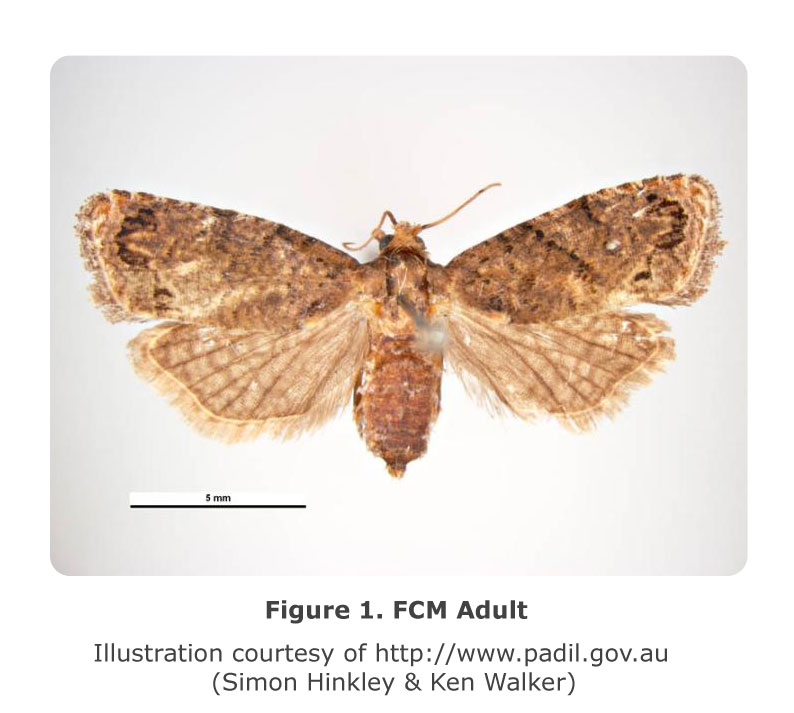False Codling Moth Pest Profile


Background
This moth is originally from sub-Saharan Africa (Fig. 2-1 Map), and has become established on nearby islands and in Israel. FCM is known to occur in the following countries: Angola, Benin, Burkina Faso, Burundi, Cameroon, Cape Verde, Central African Republic, Chad, Congo Democratic Republic, Cote d’Ivoire, Eritrea, Ethiopia, Gambia, Ghana, Israel, Kenya, Madagascar, Malawi, Mali, Mauritius, Mozambique, Niger, Nigeria, Réunion, Rwanda, Saint Helena, Senegal, Sierra Leone, Somalia, South Africa, Sudan, Swaziland, Tanzania, Togo, Uganda, Zambia, and Zimbabwe (Stibick 2006). Increased international trade and tourism between the United States and many African countries in recent years has increased the risk of introduction of this pest. Since 1984, FCM has been intercepted over 1500 times on 99 plant taxa at 34 U.S. ports of entry. In June 2005, live FCM caterpillars were found at California’s border stations inside previously cold treated Clementine citrus from South Africa. Its discovery in California is a new record for the Americas.
Description
Adults are small, brownish-gray, nocturnal moths with an average wingspan of 16 mm (2/3"). (Fig. 1) Eggs are whitish, flat and oval in outline. Young caterpillars are whitish and spotted, while mature ones are pinkish with red above and 15 mm in length. Pupation occurs in the soil or in bark crevasses within a cocoon made of silk and debris particles.
Host and Damage
Many fruit trees, field crops, and other plants have been reported as hosts for FCM ( Stibick 2006, Venette et al. 2003). In Africa, it is a major pest of citrus and cotton. Other commonly grown agricultural hosts in California include grapes, peach, plum, cherry, beans, tomato, pepper, persimmon, apricot, olive, pomegranate, English walnut, and corn. It has been reported to damage avocados, but apparently can not complete development within the fruit. Other hosts include Surinam cherry, mangosteen, cacao, guava, okra, sorghum, cowpea, mango, litchi, oak, wild fig, banana, pineapple, macadamia nuts, carambola, tea, coffee, cola nuts, sodom apple, sour sop, custard apple, and many indigenous African plants.
Host List:
Life Cycle and Damage
This moth is multivoltine with up to six generations a year in South Africa. Its generation time is 45-100 days, and the larvae are internal feeders. Females lay 100-250 individual eggs during their lifetime on fruit or foliage. Eggs are usually laid singly on the surface of fruit. Newly emerged caterpillars may wander on the surface of the fruit before entering. Caterpillars bore into fruit, thereby rendering it undesirable for consumption and allowing for the introduction and growth of bacteria and other microorganisms. Infested fruit generally drops before harvest; however, infestations that occur near fruit harvest may not be detected and infested fruit may be subsequently packaged for export. When emerging on cotton bolls, caterpillars first mine the walls and later move into the cavity and feed on seeds. Mature caterpillars leave the fruit and spin cocoons in the soil or in bark crevasses.
Survey Methods
There is a pheromone lure for the males, namely 50:50 mixture of (Z): (E)-8-dodecenyl acetate. The lure lasts 8 weeks. Traps should be put in host trees at ca. 1.5 m in height or higher, and on stakes in row crops.
Management
Various insecticides, sterile insect technique, mating disruption, attract-and-kill, and parasitoids have been used or researched as control measures elsewhere.
Economic Impact
Based on its status as a pest in Africa, establishment of FCM in California and/or in other parts of the United States could result in significant economic losses. FCM would likely be a significant production and quarantine issue for numerous agricultural commodities. In California alone, the annual combined gross value of the top ten agricultural commodities which would be directly impacted by this pest is over $7.1 billion, which amounts to 22% of the total agricultural value for the State (USDA NASS 2007).
Environmental Impact
Establishment of this moth could cause direct environmental damage via increased pesticide use statewide by commercial and residential growers and via adverse feeding impacts on native plants. Populations of threatened and endangered plant species could be severely threatened or extirpated should this moth adapt to feeding on them.
Methods of Artificial Spread
The most significant route of artificial spread is likely to be on fresh produce. Other methods of spread are on plants sold through nurseries and destined for commercial, ornamental and garden plantings; green waste; and conveyances.
Literature Cited
- USDA–APHIS–PPQ–Emergency and Domestic Programs, Riverdale, Maryland .
— Stibick, J. 2006 New Pest Response Guidelines: False Codling Moth Thaumatotibia leucotreta. - USDA, National Agricultural Statistics Service, California Field Office, Sacramento, California. 92 pp.
— USDA NASS. 2007 California Agricultural Statistics, 2006 Crop Year. - University of Minnesota, Department of Entomology, CAPS PRA. 1-30 pp.
— Venette, R. C., E. E. Davis, M. DaCosta, H. Heisler, and M. Larson. 2003. Mini Risk Assessment: False codling moth, Thaumatotibia (=Cryptophlebia) leucotreta (Meyrick) [Lepidoptera: Tortricidae - False codling moth (Thaumatotibia leucotreta).
— Walker, K. 2007 Pest and Diseases Image Library. Updated on 22/12/2007 11:41:38 AM. [http://www.padil.gov.au]
